Spectral Analysis: Exercise 4
Cyclotron absorption line in Hercules X-1
In this exercise the approach will be to take note of more subtle aspects
of the spectra and define the model components accordingly. The source is
Hercules X-1
, observed by the Phoswich Detector System aboard the European X-ray satellite
BeppoSax. Lets start the process.
Copy required files, herx-1_pds.pha
, pds_256.rmf
and invoke xspec
pulsar>xspec
XSPEC>cpd /xw
XSPEC>setp e
XSPEC>da pds_nobins.pha
Net count rate (cts/s) for file 1 36.77 +/- 3.9759E-02
using response (RMF) file... pds_256.rmf
1 data set is in use
XSPEC>pl ld
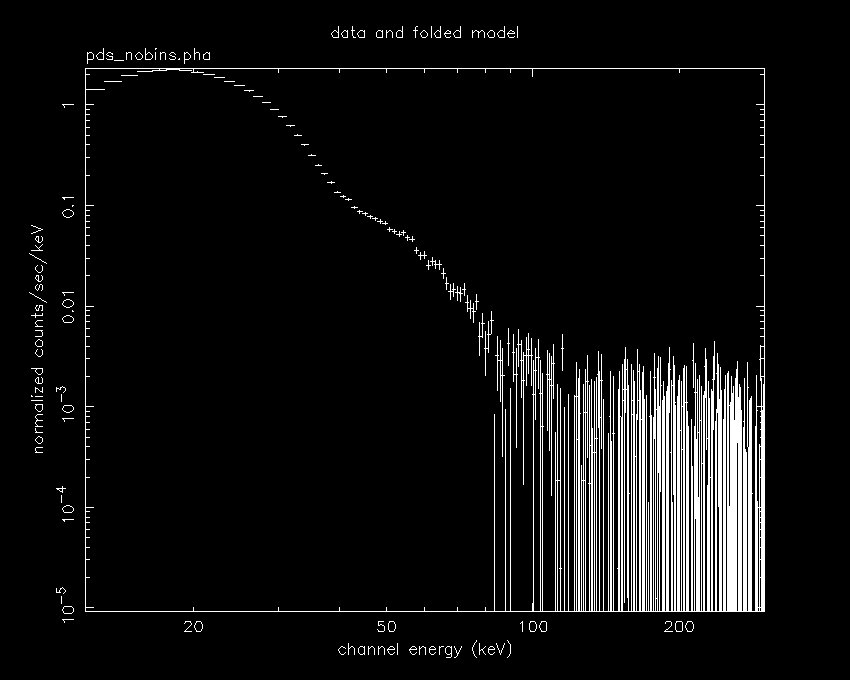
Ignore the obvious bad data above 100 keV.
XSPEC>ig 100.-**
Note the energy range (of the PDS) in which we are working for this
source. The energy range is very important for deciding the model components,
for all physical processes which are applicable for a data set are decided
by the energy range of the data, and vice versa. The absorption due to the
effective hydrogen column is negligible above 10.0 keV, hence we will start
with only powerlaw to fit the data.
XSPEC>mo power
Model: powerlaw[1]
Input parameter value, delta, min, bot, top, and max values for ...
Current: 1 0.01 -3 -2 9 10
powerlaw:PhoIndex>1.5
Current: 1 0.01 0 0 1E+24 1E+24
powerlaw:norm>0.6
..
XSPEC>fit
..
..
---------------------------------------------------------------------------
---------------------------------------------------------------------------
Model: powerlaw[1]
Model Fit Model Component Parameter Unit Value
par par comp
1 1 1 powerlaw PhoIndex 2.687 +/- 0.2232E-02
2 2 1 powerlaw norm 11.04 +/- 0.7228E-01
---------------------------------------------------------------------------
---------------------------------------------------------------------------
Chi-Squared = 161929.0 using 78 PHA bins.
Reduced chi-squared = 2130.645 for 76 degrees of freedom
Null hypothesis probability = 0.00
Well, the fit appears to be quite hopeless. See the spectra and residual.
XSPEC>pl ld chi
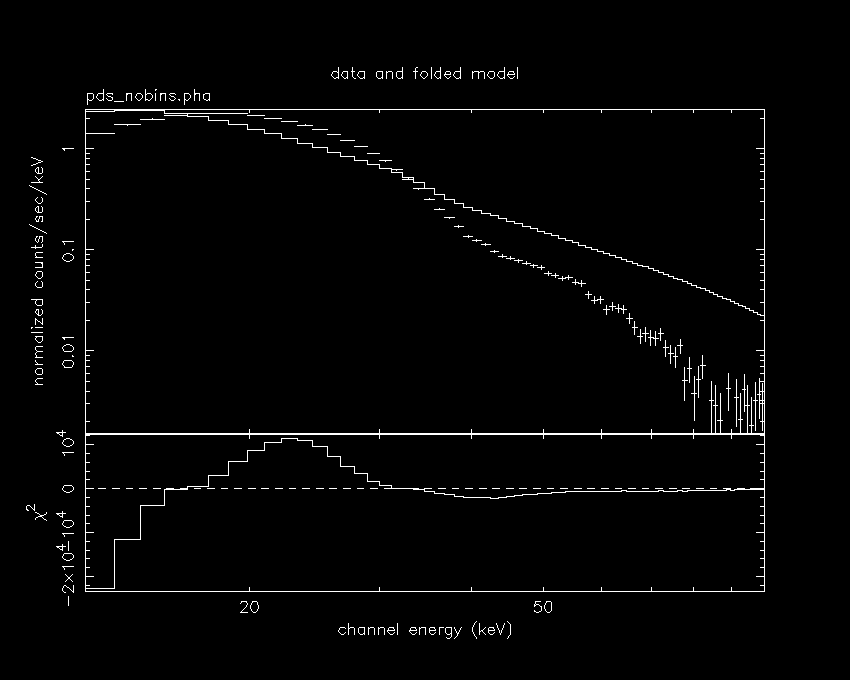
Well, at first glance the best fit doesn't look so optimistic, but if you
look closely you'll realise that if the powerlaw index is harder (~1.5)
and assume there is an exponential cutoff at around 25-30 keV, the fit will
definitely improve. So effectively we should be fitting a cutoff-powerlaw
model.
XSPEC>addcomp 2 highecut
Input parameter value, delta, min, bot, top, and max values for ...
Current: 10 0.01 1E-04 0.01 1E+06 1E+06
highecut:cutoffE>25.0
Current: 15 0.01 1E-04 0.01 1E+06 1E+06
highecut:foldE>15.0
..
XSPEC>fit
..
..
..
---------------------------------------------------------------------------
---------------------------------------------------------------------------
Model: ( powerlaw[1] )highecut[2]
Model Fit Model Component Parameter Unit Value
par par comp
1 1 1 powerlaw PhoIndex 0.9346 +/- 0.8624E-02
2 2 1 powerlaw norm 8.1404E-02 +/- 0.1935E-02
3 3 2 highecut cutoffE keV 22.51 +/- 0.4029E-01
4 4 2 highecut foldE keV 8.494 +/- 0.2794E-01
---------------------------------------------------------------------------
---------------------------------------------------------------------------
Chi-Squared = 3298.195 using 78 PHA bins.
Reduced chi-squared = 44.57020 for 74 degrees of freedom
Null hypothesis probability = 0.00
The best fit statistics is still very poor, lets examine the spectra again.
XSPEC>pl ld chi
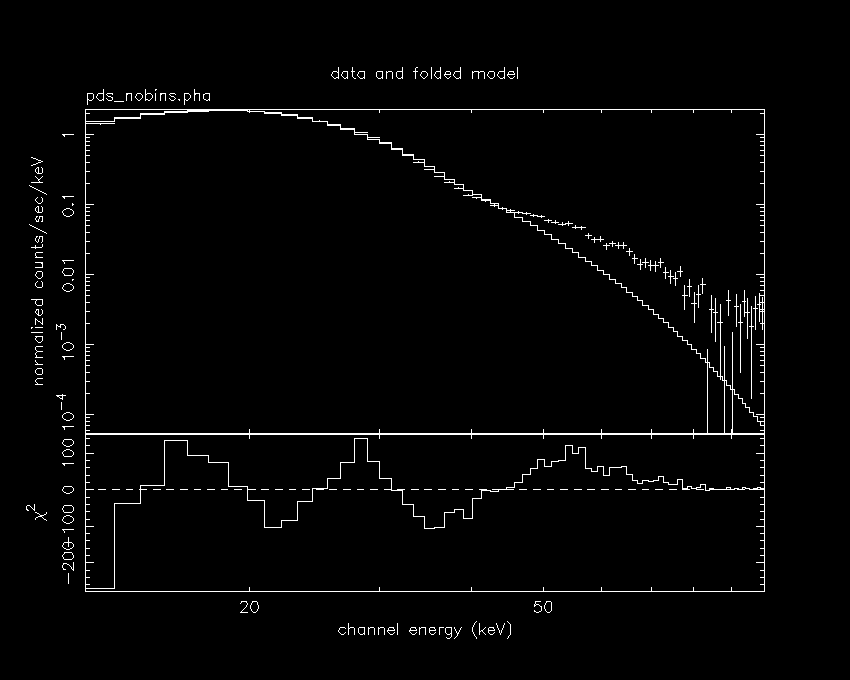
Two main things are there to be noticed, firstly, the residual below 15
keV is very large, we will deal with this problem later. Secondly, from the
shape of the spectra and the best fit model above ~25 keV, one can realise
that if the powerlaw index beomes softer with higher normalization
than the presnt value (i.e. ~1.5) and if we introduce an absorption line around
35 keV then the fit will improve. The best candidate for the absorption is
the cyclotron absorption line, becasue of the extremely high magnetic field
present in a pulsar.
XSPEC>addcomp 3 cycl
Input parameter value, delta, min, bot, top, and max values for ...
Current: 2 0.01 0 0 100 100
cyclabs:Depth0>
Current: 30 0.01 1 1 100 100
cyclabs:E0>
Current: 10 -0.01 1 1 100 100
cyclabs:Width0>
Current: 0 -0.01 0 0 100 100
cyclabs:Depth2>
Current: 20 -0.01 1 1 100 100
cyclabs:Width2>
..
XSPEC>fit
..
..
You will get the best fit statistics something like this
---------------------------------------------------------------------------
---------------------------------------------------------------------------
Model: ( powerlaw[1] )highecut[2]*cyclabs[3]
Model Fit Model Component Parameter Unit Value
par par comp
1 1 1 powerlaw PhoIndex 1.148 +/- 0.1344E-01
2 2 1 powerlaw norm 0.1586 +/- 0.6022E-02
3 3 2 highecut cutoffE keV 23.53 +/- 0.9010E-01
4 4 2 highecut foldE keV 13.23 +/- 0.1099
5 5 3 cyclabs Depth0 0.8494 +/- 0.1634E-01
6 6 3 cyclabs E0 keV 38.39 +/- 0.1293
7 7 3 cyclabs Width0 keV 10.00 frozen
8 8 3 cyclabs Depth2 0.000 frozen
9 9 3 cyclabs Width2 keV 20.00 frozen
---------------------------------------------------------------------------
---------------------------------------------------------------------------
Chi-Squared = 246.5020 using 75 PHA bins.
Reduced chi-squared = 3.572492 for 69 degrees of freedom
Null hypothesis probability = 8.860E-22
The fit has improved considerably, but is not yet acceptable. Again look
closely at the sepctra and best fit model and the residual.
XSPEC>pl ld chi
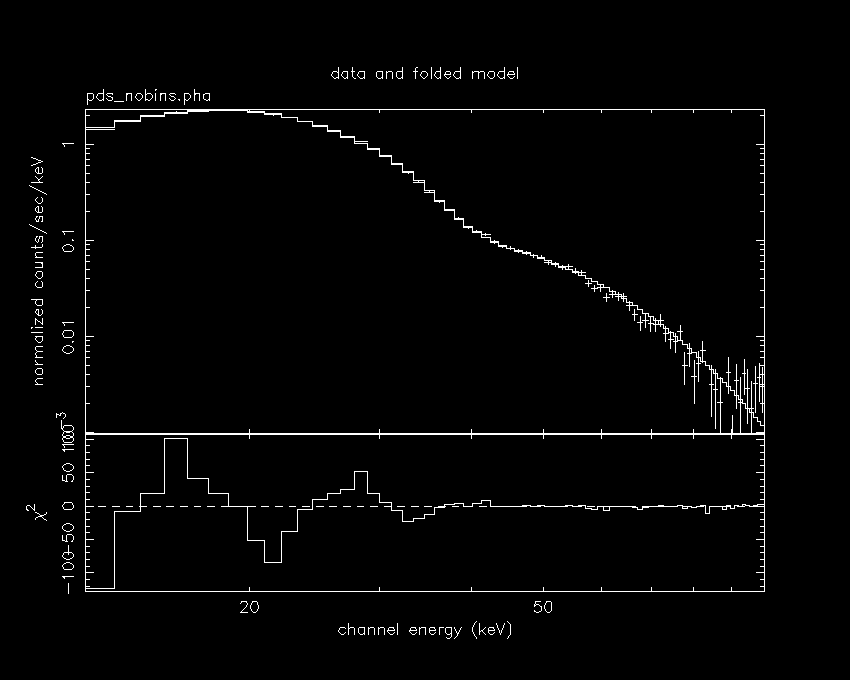
Well, we have no other choice but to exclude the poor quality data below
20 keV, the maximum contribution to the chi-square is coming from those energy
channels.
XSPEC>ig **-20.0
..
XSPEC>fit
..
..
..
---------------------------------------------------------------------------
---------------------------------------------------------------------------
Model: ( powerlaw[1] )highecut[2]*cyclabs[3]
Model Fit Model Component Parameter Unit Value
par par comp
1 1 1 powerlaw PhoIndex 1.602 +/- 0.7130E-01
2 2 1 powerlaw norm 0.6264 +/- 0.1329
3 3 2 highecut cutoffE keV 25.40 +/- 0.2601
4 4 2 highecut foldE keV 14.86 +/- 0.3285
5 5 3 cyclabs Depth0 0.7935 +/- 0.1704E-01
6 6 3 cyclabs E0 keV 37.80 +/- 0.1692
7 7 3 cyclabs Width0 keV 10.00 frozen
8 8 3 cyclabs Depth2 0.000 frozen
9 9 3 cyclabs Width2 keV 20.00 frozen
---------------------------------------------------------------------------
---------------------------------------------------------------------------
Chi-Squared = 111.5360 using 70 PHA bins.
Reduced chi-squared = 1.742750 for 64 degrees of freedom
Null hypothesis probability = 2.173E-04
Now thaw the paramter cyclotron absorption width, even though it may
not affect the best fit statistics much, it will definitely give better acceptable
value of other best fit parameters.
XSPEC>thaw 7
XSPEC>fit
..
..
..
---------------------------------------------------------------------------
---------------------------------------------------------------------------
Model: ( powerlaw[1] )highecut[2]*cyclabs[3]
Model Fit Model Component Parameter Unit Value
par par comp
1 1 1 powerlaw PhoIndex 1.607 +/- 0.6692E-01
2 2 1 powerlaw norm 0.6467 +/- 0.1247
3 3 2 highecut cutoffE keV 25.82 +/- 0.3008
4 4 2 highecut foldE keV 14.99 +/- 0.2772
5 5 3 cyclabs Depth0 0.8189 +/- 0.3025E-01
6 6 3 cyclabs E0 keV 37.45 +/- 0.3110
7 7 3 cyclabs Width0 keV 10.88 +/- 0.7241
8 8 3 cyclabs Depth2 0.000 frozen
9 9 3 cyclabs Width2 keV 20.00 frozen
---------------------------------------------------------------------------
---------------------------------------------------------------------------
Chi-Squared = 109.1144 using 70 PHA bins.
Reduced chi-squared = 1.731975 for 63 degrees of freedom
Null hypothesis probability = 2.811E-04
Look at the sepctra and the residual.
XSPEC>pl
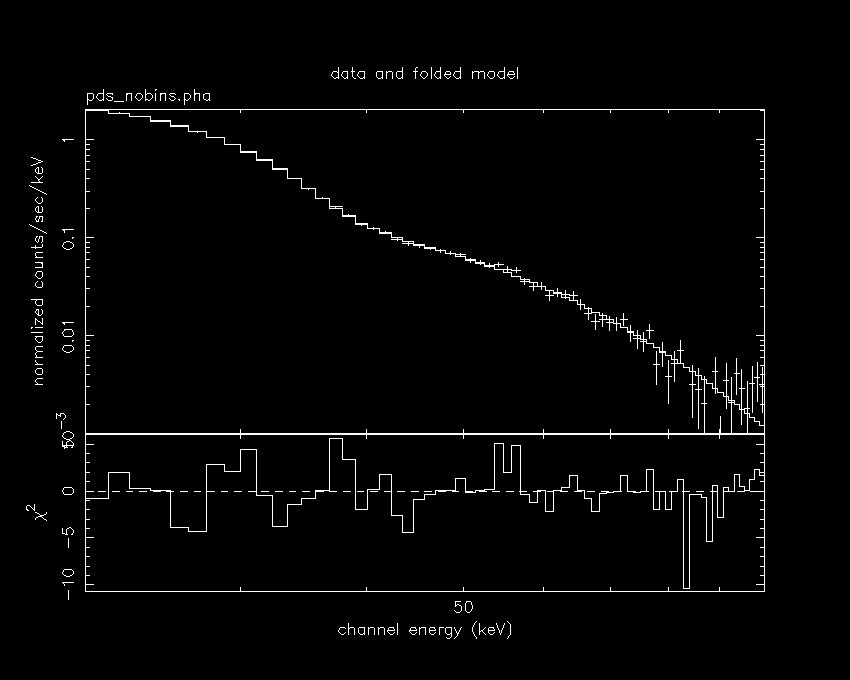
The fit may not look to be as good as the ones in our previous exercises,
but still it is definitely acceptable for at least qualitative discusion and
convincing evidence for the presence of the cyclotron absorption line. Look
at the unfolded spectra to acknowledge the convincing presence of the cyclotron
absorption line.
Detection of this cyclotron absorption feature in the spectrum allows you to estimate the
magnetic field strength of the neutron star. This is the only direct way of measuring magnetic
field strength of a neutron star.
XSPEC>pl uf
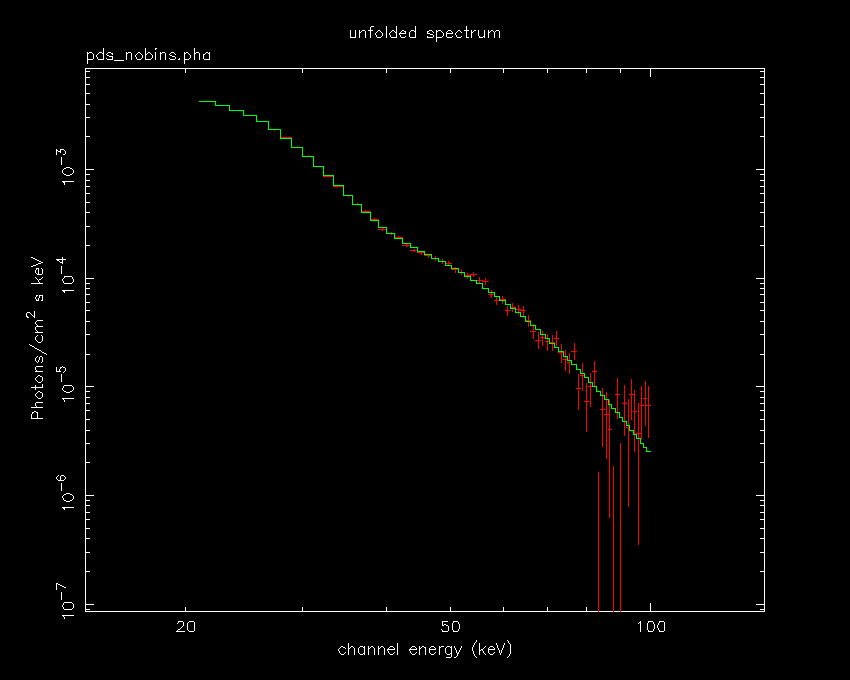
So, here ends the exercise in which we had to observe the shape of the
spectra to decide on the course of action while fitting the model. Here we
have covered most of the basic aspects of the spectral fitting of X-ray data
using xspec.
|


